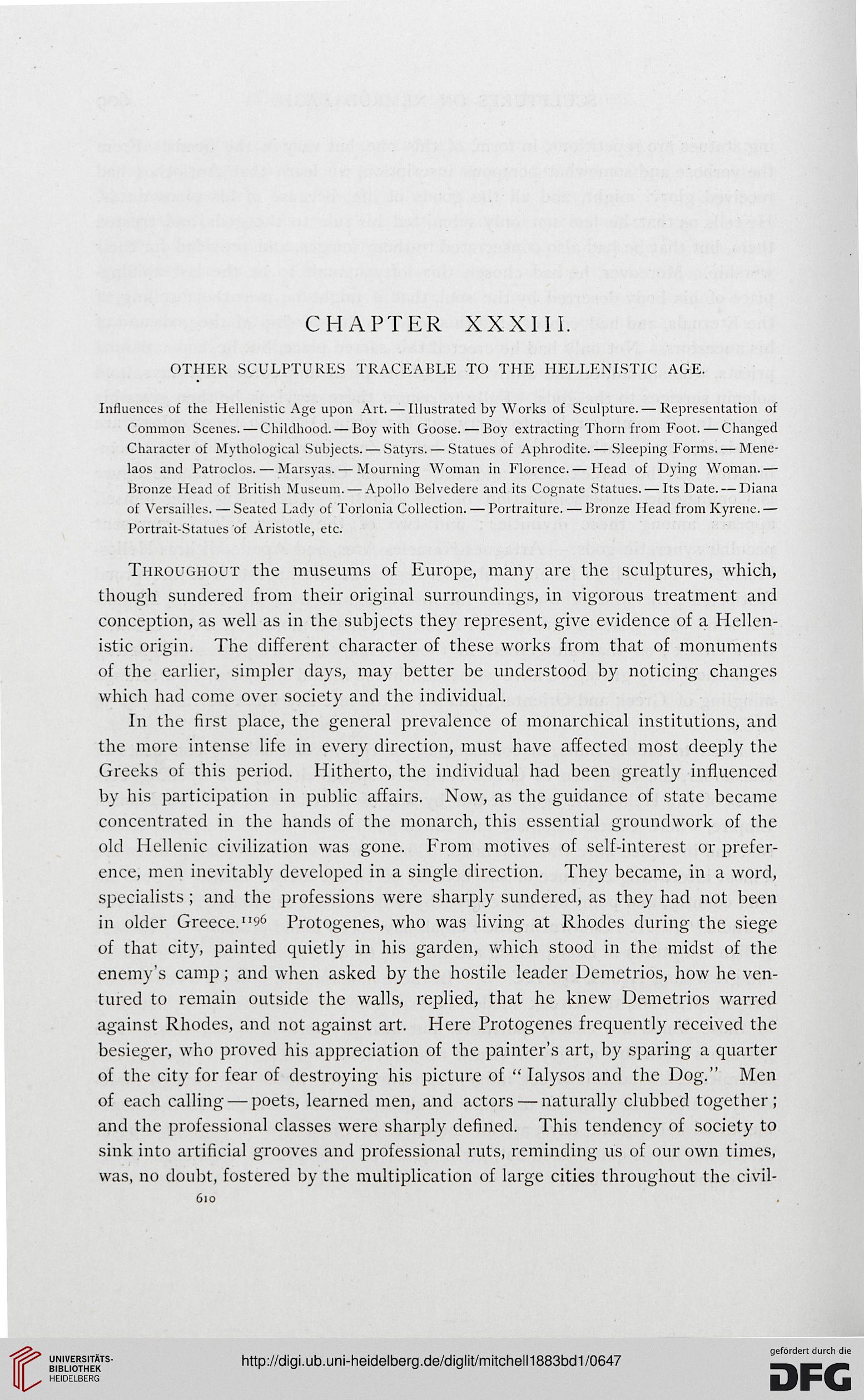CHAPTER XXXIII.
OTHER SCULPTURES TRACEABLE TO THE HELLENISTIC AGE.
Influences of the Hellenistic Age upon Art. — Illustrated by Works of Sculpture. — Representation of
Common Scenes. — Childhood. — Boy with Goose. — Boy extracting Thorn from Foot. — Changed
Character of Mythological Subjects. — Satyrs. — Statues of Aphrodite. — Sleeping Forms. — Mene-
laos and Patroclos. — Marsyas. — Mourning Woman in Florence. — Head of Dying Woman.—
Bronze Head of British Museum. — Apollo Belvedere and its Cognate Statues. — Its Date. — Diana
of Versailles. — Seated Lady of Torlonia Collection. — Portraiture. — Bronze Head from Kyrene. —
Portrait-Statues of Aristotle, etc.
Throughout the museums of Europe, many are the sculptures, which,
though sundered from their original surroundings, in vigorous treatment and
conception, as well as in the subjects they represent, give evidence of a Hellen-
istic origin. The different character of these works from that of monuments
of the earlier, simpler days, may better be understood by noticing changes
which had come over society and the individual.
In the first place, the general prevalence of monarchical institutions, and
the more intense life in every direction, must have affected most deeply the
Greeks of this period. Hitherto, the individual had been greatly influenced
by his participation in public affairs. Now, as the guidance of state became
concentrated in the hands of the monarch, this essential groundwork of the
old Hellenic civilization was gone. From motives of self-interest or prefer-
ence, men inevitably developed in a single direction. They became, in a word,
specialists ; and the professions were sharply sundered, as they had not been
in older Greece. IK->° Protogenes, who was living at Rhodes during the siege
of that city, painted quietly in his garden, which stood in the midst of the
enemy's camp; and when asked by the hostile leader Demetrios, how he ven-
tured to remain outside the walls, replied, that he knew Demetrios warred
against Rhodes, and not against art. Here Protogenes frequently received the
besieger, who proved his appreciation of the painter's art, by sparing a quarter
of the city for fear of destroying his picture of " Ialysos and the Dog." Men
of each calling — poets, learned men, and actors — naturally clubbed together;
and the professional classes were sharply defined. This tendency of society to
sink into artificial grooves and professional ruts, reminding us of our own times,
was, no doubt, fostered by the multiplication of large cities throughout the civil-
610
OTHER SCULPTURES TRACEABLE TO THE HELLENISTIC AGE.
Influences of the Hellenistic Age upon Art. — Illustrated by Works of Sculpture. — Representation of
Common Scenes. — Childhood. — Boy with Goose. — Boy extracting Thorn from Foot. — Changed
Character of Mythological Subjects. — Satyrs. — Statues of Aphrodite. — Sleeping Forms. — Mene-
laos and Patroclos. — Marsyas. — Mourning Woman in Florence. — Head of Dying Woman.—
Bronze Head of British Museum. — Apollo Belvedere and its Cognate Statues. — Its Date. — Diana
of Versailles. — Seated Lady of Torlonia Collection. — Portraiture. — Bronze Head from Kyrene. —
Portrait-Statues of Aristotle, etc.
Throughout the museums of Europe, many are the sculptures, which,
though sundered from their original surroundings, in vigorous treatment and
conception, as well as in the subjects they represent, give evidence of a Hellen-
istic origin. The different character of these works from that of monuments
of the earlier, simpler days, may better be understood by noticing changes
which had come over society and the individual.
In the first place, the general prevalence of monarchical institutions, and
the more intense life in every direction, must have affected most deeply the
Greeks of this period. Hitherto, the individual had been greatly influenced
by his participation in public affairs. Now, as the guidance of state became
concentrated in the hands of the monarch, this essential groundwork of the
old Hellenic civilization was gone. From motives of self-interest or prefer-
ence, men inevitably developed in a single direction. They became, in a word,
specialists ; and the professions were sharply sundered, as they had not been
in older Greece. IK->° Protogenes, who was living at Rhodes during the siege
of that city, painted quietly in his garden, which stood in the midst of the
enemy's camp; and when asked by the hostile leader Demetrios, how he ven-
tured to remain outside the walls, replied, that he knew Demetrios warred
against Rhodes, and not against art. Here Protogenes frequently received the
besieger, who proved his appreciation of the painter's art, by sparing a quarter
of the city for fear of destroying his picture of " Ialysos and the Dog." Men
of each calling — poets, learned men, and actors — naturally clubbed together;
and the professional classes were sharply defined. This tendency of society to
sink into artificial grooves and professional ruts, reminding us of our own times,
was, no doubt, fostered by the multiplication of large cities throughout the civil-
610




